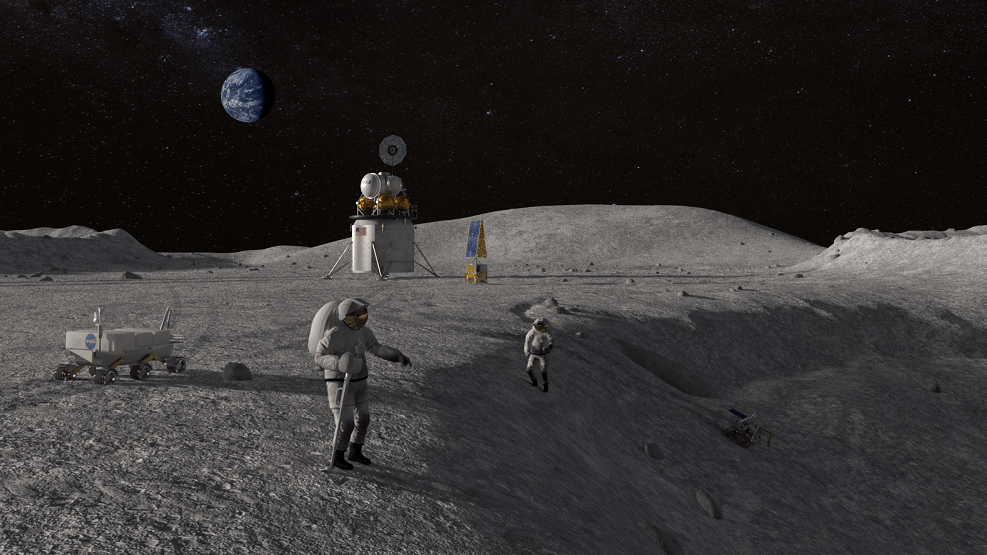The Canadian Space Agency (CSA) has a long-standing tradition of innovation and technological development in space. Who can forget the Shuttle Remote Manipulator System (SRMS), more familiarly known as the " Canadarm ", which was essential to the Space Shuttle program? How about its successor, the Canadarm2, which is a crucial part of the International Space Station and even helped assemble it?
Looking to the future, the CSA intends to play a similar role in humanity's return to the Moon - which includes the creation of the Lunar Gateway and Project Artemis. To this end, the CSA recently awarded a series of contracts with private businesses and one university to foster the development of technologies that would assist with national and international efforts to explore the Moon.
Specifically, the CSA has awarded 7 contracts worth a total of $4.36 million to 5 companies and one university to produce concepts that will advance Canada's efforts to conduct landings and science operations on the surface of the Moon. The specified concepts include nano-rovers, micro-rovers, and autonomous science instruments.
Funding for these projects was made through theCSA's Lunar Exploration Accelerator Program (LEAP), which is tasked with preparing Canada's space sector for the coming decade of lunar exploration. To this end, LEAP has earmarked a total of $150 million that will be distributed over the next five years to stimulate innovation in the fields of artificial intelligence, robotics, health, and other associated technologies.
As the Honourable Navdeep Bains - the Minister of Innovation, Science and Industry - remarked:
“Our Government is positioning Canada’s space sector to reach for the Moon and beyond. This investment will help Canadian businesses bring their technologies to market, creating opportunities for them to join the growing space economy while supporting Canada to achieve world firsts in space science and exploration.”
Of the contracts and funding that have been awarded so far, the largest share was secured by the Canadensys Aerospace Corporation, located in Caledon, Ontario. This company, which specializes in space systems and services, will receive two contracts worth a total of $1,099,366 for the sake of designing and developing technologies and prototypes for two different classes of small lunar science rovers (the nano- and micro-rover).
Another Ontario-based company that was awarded a contract is Bubble Technology Industries Inc, which specializes in radiation-related applications. In exchange for the $698,321 they will receive, Bubble will develop a spectrometer that can search for hydrogen autonomously, thus allowing future missions to detect the presence of water and ice near the lunar surface.
Quebec-based aerospace developer ABB was also awarded a contract for the development of autonomous technology. In exchange for the $693,193 they were issued, they will design, build and test a prototype for an autonomous infrared spectrometer. This device will act as a mineral mapper, giving future robotic missions the ability to remotely measure and the composition of the Moon's surface.
Magellan Aerospace - the global developer of aerospace technologies headquartered in Mississauga, Ontario - was issued a contract totaling $607,258 to develop a lunar impactor that will deliver instruments to the surface of the Moon. These will include sensors designed to detect water within the permanently shadowed regions around the southern polar region of the Moon.
Rounding out the companies, Mission Control Space Services Inc. (from Ottawa, Ontario) was awarded a contract worth $573,829 to develop two software packages. These will consist of an Autonomous Soil Assessment System (ASAS) that will study the composition of lunar regolith and an AI-based science support tool that will help rovers navigate the challenging lunar terrain.
And then there's Western University in London, Ontario, which was awarded a contract totaling $690,123 to develop the Integrated Vision System. This system will be designed by Western's Institute for Earth and Space Exploration (aka. Western Space) and will be used for surface operations to identify lunar geology and assist in rover navigation.
These and other related technologies are essential to what space agencies have planned for the coming decade, not the least of which will be the creation of a lunar base in the southern polar region. Looking even farther, these kinds of partnerships - not only between space agencies but between government, industry, and academic institutions as well - will be essential to humanity becoming an "interplanetary species."
In short, when astronauts set foot on the Moon and Mars in this decade and the next, their success will be the result of collaborative efforts. We can also expect that several flags will be flying there!
*Further Reading: Parabolic Arc*
 Universe Today
Universe Today



